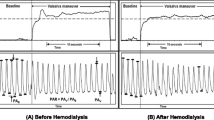Abstract
Objective: Changes in the contour of the plethysmographically recorded digital pulse curve after nitrate ingestion are well known, but it has not been fully established whether these changes reflect nitrate action on left ventricular (LV) preload or afterload. Therefore, we compared the pulse wave contour after administration of equieffective doses of nitroglycerin and nifedipine.
Methods:
In 20 patients with coronary artery disease we measured aortic blood pressure curve in the aorta ascendens, digital volume pulse curve with a photoelectric pulse pickup, Riva Rocci blood pressure and heart rate after administration of either 0.8 mg nitroglycerin or 10 mg nifedipine.
Results:
Peak plasma concentrations of nitroglycerin and nifedipine were achieved 5 min and 20 min after ingestion of the drugs. Systolic aortic blood pressure decreased after both nitroglycerin and nifedipine to 19.4 mmHg, but diastolic blood pressure decreased only after nifedipine by 10.5 mmHg (P < 0.05). Riva Rocci blood pressures showed a similar time course. Heart rate increased from 67.4 to 70.9 beats⋅min−1 after nitroglycerin and from 58.9 to 69.4 beats⋅min−1 after nifedipine. The calculated a/b ratio of the aortic pressure curve increased after both medications (nitroglycerin, from 1.66 to 1.99; nifedipine, from 1.66 to 1.93) and its time course mimicked that of the systolic blood pressure. The a/b ratio of the digital pulse curve did not change after nifedipine, but showed a pronounced rise after nitroglycerin from 1.29 to 1.84.
With regard to pharmacological actions, nitroglycerin causes a reduction in LV preload and afterload, whereas nifedipine has only LV-afterload-reducing activity.
Conclusion:
We conclude, that the reduction in afterload did not cause the typical changes in wave contour of the peripheral pulse curve which occur with organic nitrates. Most likely changes in the a/b ratio reflect changes in LV preload.
Similar content being viewed by others
Author information
Authors and Affiliations
Additional information
Received: 16 May 1995/Accepted in revised form: 9 November 1995
Rights and permissions
About this article
Cite this article
Stengele, E., Winkler, F., Trenk, D. et al. Digital pulse plethysmography as a non-invasive method for predicting drug-induced changes in left ventricular preload. E J Clin Pharmacol 50, 279–282 (1996). https://doi.org/10.1007/s002280050108
Issue Date:
DOI: https://doi.org/10.1007/s002280050108




